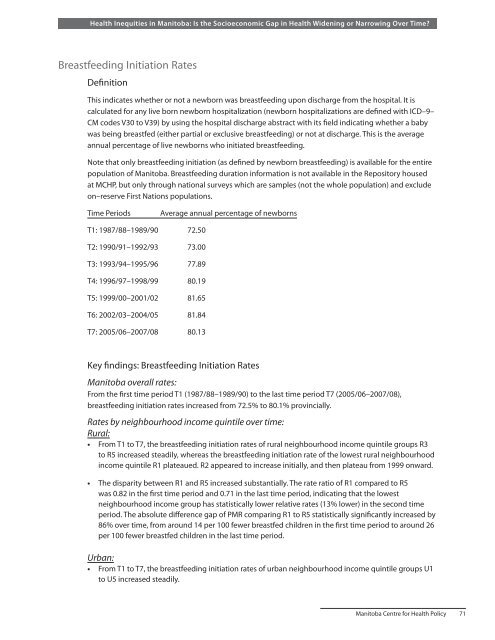Health Inequities in Manitoba: Is the Socioeconomic Gap
Health Inequities in Manitoba: Is the Socioeconomic Gap
Health Inequities in Manitoba: Is the Socioeconomic Gap
Create successful ePaper yourself
Turn your PDF publications into a flip-book with our unique Google optimized e-Paper software.
<strong>Health</strong> <strong>Inequities</strong> <strong>in</strong> <strong>Manitoba</strong>: <strong>Is</strong> <strong>the</strong> <strong>Socioeconomic</strong> <strong>Gap</strong> <strong>in</strong> <strong>Health</strong> Widen<strong>in</strong>g or Narrow<strong>in</strong>g Over Time?<br />
Breastfeed<strong>in</strong>g Initiation Rates<br />
Def<strong>in</strong>ition<br />
This <strong>in</strong>dicates whe<strong>the</strong>r or not a newborn was breastfeed<strong>in</strong>g upon discharge from <strong>the</strong> hospital. It is<br />
calculated for any live born newborn hospitalization (newborn hospitalizations are def<strong>in</strong>ed with ICD–9–<br />
CM codes V30 to V39) by us<strong>in</strong>g <strong>the</strong> hospital discharge abstract with its field <strong>in</strong>dicat<strong>in</strong>g whe<strong>the</strong>r a baby<br />
was be<strong>in</strong>g breastfed (ei<strong>the</strong>r partial or exclusive breastfeed<strong>in</strong>g) or not at discharge. This is <strong>the</strong> average<br />
annual percentage of live newborns who <strong>in</strong>itiated breastfeed<strong>in</strong>g.<br />
Note that only breastfeed<strong>in</strong>g <strong>in</strong>itiation (as def<strong>in</strong>ed by newborn breastfeed<strong>in</strong>g) is available for <strong>the</strong> entire<br />
population of <strong>Manitoba</strong>. Breastfeed<strong>in</strong>g duration <strong>in</strong>formation is not available <strong>in</strong> <strong>the</strong> Repository housed<br />
at MCHP, but only through national surveys which are samples (not <strong>the</strong> whole population) and exclude<br />
on–reserve First Nations populations.<br />
Time Periods Average annual percentage of newborns<br />
T1: 1987/88–1989/90 72.50<br />
T2: 1990/91–1992/93 73.00<br />
T3: 1993/94–1995/96 77.89<br />
T4: 1996/97–1998/99 80.19<br />
T5: 1999/00–2001/02 81.65<br />
T6: 2002/03–2004/05 81.84<br />
T7: 2005/06–2007/08 80.13<br />
Key f<strong>in</strong>d<strong>in</strong>gs: Breastfeed<strong>in</strong>g Initiation Rates<br />
<strong>Manitoba</strong> overall rates:<br />
From <strong>the</strong> first time period T1 (1987/88–1989/90) to <strong>the</strong> last time period T7 (2005/06–2007/08),<br />
breastfeed<strong>in</strong>g <strong>in</strong>itiation rates <strong>in</strong>creased from 72.5% to 80.1% prov<strong>in</strong>cially.<br />
Rates by neighbourhood <strong>in</strong>come qu<strong>in</strong>tile over time:<br />
Rural:<br />
• From T1 to T7, <strong>the</strong> breastfeed<strong>in</strong>g <strong>in</strong>itiation rates of rural neighbourhood <strong>in</strong>come qu<strong>in</strong>tile groups R3<br />
to R5 <strong>in</strong>creased steadily, whereas <strong>the</strong> breastfeed<strong>in</strong>g <strong>in</strong>itiation rate of <strong>the</strong> lowest rural neighbourhood<br />
<strong>in</strong>come qu<strong>in</strong>tile R1 plateaued. R2 appeared to <strong>in</strong>crease <strong>in</strong>itially, and <strong>the</strong>n plateau from 1999 onward.<br />
• The disparity between R1 and R5 <strong>in</strong>creased substantially. The rate ratio of R1 compared to R5<br />
was 0.82 <strong>in</strong> <strong>the</strong> first time period and 0.71 <strong>in</strong> <strong>the</strong> last time period, <strong>in</strong>dicat<strong>in</strong>g that <strong>the</strong> lowest<br />
neighbourhood <strong>in</strong>come group has statistically lower relative rates (13% lower) <strong>in</strong> <strong>the</strong> second time<br />
period. The absolute difference gap of PMR compar<strong>in</strong>g R1 to R5 statistically significantly <strong>in</strong>creased by<br />
86% over time, from around 14 per 100 fewer breastfed children <strong>in</strong> <strong>the</strong> first time period to around 26<br />
per 100 fewer breastfed children <strong>in</strong> <strong>the</strong> last time period.<br />
Urban:<br />
• From T1 to T7, <strong>the</strong> breastfeed<strong>in</strong>g <strong>in</strong>itiation rates of urban neighbourhood <strong>in</strong>come qu<strong>in</strong>tile groups U1<br />
to U5 <strong>in</strong>creased steadily.<br />
<strong>Manitoba</strong> Centre for <strong>Health</strong> Policy 71


